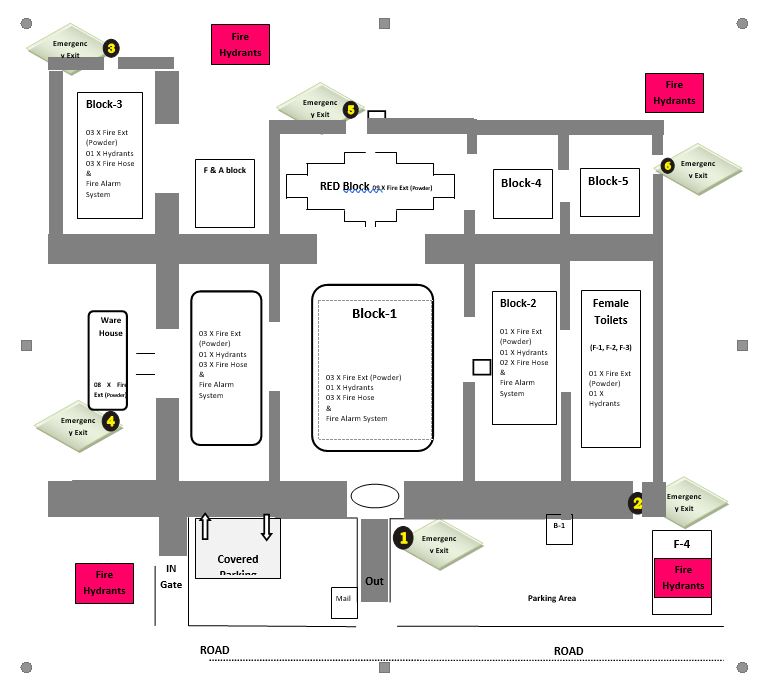
Dynamic Business Environment
December 24, 2020
Literature Review Report
December 24, 2020Fire protection systems are like superheroes for buildings, working to keep them safe from fires. These systems are designed to detect and put out fires or give a warning so everyone can escape in time.
Fire protection system and the associated fire protection strategies are of key importance to any building.
Introduction
Safety is an integral part of the modern world building designs and the Engineers/designers around the word have developed key procedures that can help in modeling active fire protection systems.
This review highlights the importance of fire safety strategies and the tools that may be used for fire protection in buildings such as stores, cinemas etc. A brief discussion regarding the most suited protections systems, design and safety policies will be followed by evacuation procedures in high rise public buildings.
1. General Prevention
The prevention of fire is of more importance than fire fighting & must be the first consideration of entire community. Most fire outbreaks are caused by irregularities or carelessness. Tidiness & cleanliness are basis of good fire precaution. Before the fire protection systems are designed and installed, it is important to review the possibilities of fire breakout and its causes for specific building occupants. In this case study, the possible causes of fire out break are analyzed for large public buildings such as IKEA type stores.
2. Causes of Fire Outbreak
Analyzing the residential behavior of the building occupants can highlight many aspects of the possible fire hazard. For large commercial buildings such as IKEA, many fire outbreaks are normally caused by;
- Smoking or the use of naked light (specially in storage areas or near waste collection drums)
- Static Electricity
- Use of Ferrous Tools
- Transport Vehicles Parked with Running Engines
- Terrorist Activity
These analyses are considered to be very important as the ‘final design of the safety strategies and tools for fire protections’ heavily depends on its outcomes.
3. Fire Precautions
Once the possible fire outbreaks analyses are completed, fire precautionary measures are considered so that the designers can estimate the risk factors and produce numerical models of fire appropriately. For example, storage of highly flammable liquors can be banned inside the building so that it assumed that no explosive materials will be present inside the building in the event of fire break out. The following precautionary will be implemented in this case study.
- All firefighting equipment shall be maintained in serviceable condition.
- Candles or naked light will not be used/ placed unattended.
- Fire will not be lighted at unauthorized places.
- Fire will not be left unattended.
- Smoking cigarettes will be allowed at designated places only
- Vehicles will be parked facing to the exit gate so that in emergency these are taken out without any obstruction.
- Electric fitting whether internal or external should not have loose/ naked fitting. Fuses will be repaired only by authorized persons
- Petrol/ Kerosene, Oils, diesel, or other highly flammables will not be kept in the building
- Naked lights will not be taken inside the Sensitive Material Rooms.
4. Design of Fire Protection System
The following important factors and the behavior of fire in the effected building are considered in the design of the fire protection system
- The Risk Profile; This is estimated by the types/amount of combustible materials that will be stored and placed in the building (it represents the characteristics of the occupants). The rate of energy releases and subsequent mass loss ratio are also included in the calculations. When the material(s) is ignited, the fire keeps spreading over the material until it is completely involved. The equation representing the relationship between the energy release rate and its parameters can be given as;
Where, Q is the rate of energy release/surface are (fuel), q is heat flux, Lv is the latent heat of vaporization, Hc is the heat of combustion (ASCE, 1999)
- The Growth Rates of Fire; The plot of Fire Growth against Time determines maximum time for the occupants for a safe exit. The time required to reach the designated safe zone must be greater than the time taken by fire to reach evacuation zone. It is observed that fire growth follows a time line and it would happen in discrepancy stages. In large blocks/compartment, it is more likely that the fire growth will occur sequentially. The behavior of completely developed fires and the effects of ventilation system in place is also factor that is considered in growth rate calculations.
The fire can spread through the radiation process of the burning object or through the object to object heat transfer. The fire can be ventilation controlled if the rate of the burning (based on the type of fuel and heat-flux) exceeds the available air supply in the affected area. Given the constant value of the release of heat per-unit of oxygen (assumed for normal fuels), the required air volume needed to support the fire can be determined.
- Activation Time; There are two primary stages of the activation process (i) the pre-activation time is the time required to activate the fire protection systems or sound the warning. (ii) The movement time is the time required from when the fire emergency procedures are started.
- Building Layout Design; the points discussed above are considered while the building layout design is finalized. For example the building should be protected with hearth doors to prevent fir and smoke, and structure is such that it facilitates the safe evacuation process. The methodology used for safe building layout design is discussed in the following.
5. Modeling of Fire Protection System
The ability of property to resist or withstand fire is called the fire resistance. This ability can enhance fire protection in many cases in the building. Therefore different fire ratings are required for specific buildings that are specified as building codes. These codes represent the fire resistance design based on the covered area, building-occupancy and the building load. These codes are based on the experimental results; however, the actual severity of the fire can be only determined by the many other additional factors which are note currently included in the building codes.
Recent work by researchers on fire safety using analytical methods has been quite successful and it is becoming more and more popular in engineering and safety designs of the building codes. The numerical methodology to calculate the building or structural fire resistance has also made progressive development. Numerical methods are reliable and quite cost effective and these may be applied/used in specific situation analyses (Mike, 1999)
A calculation method has been described in euro codes which can be perform calculations on the steel that is exposed to actual-fire. The following are the analyses that should be conducted for the numerical modeling of fire resistance (ASCE, 1999)
- The fire development model; It illustrates the fire heat exposure.
- The model for thermal response of the assembly(s); It illustrates the rise in temperature for the structural members
- The model for structural response; It illustrates the load-carrying capacity of the exposed structural members
Mechanical as well as thermal properties of the material are of key importance of structural member’s performance in the building. For steel, the strength and the deformation resistance decrease as the temperature increase. Same is the case with concrete; however the change in these properties can vary depending on the thickness and the quality of the material used. There are minimum requirements that need to be met; in the building structure that defines the minimum strength of the materials to be used. Trusses and beams perform differently depending on the conditions and the methods of fabrication
The structural-mechanics analyses can analyze the performance of the structural members that are exposed to the fire. The steels used in the design of the buildings are normally hot rolled or cold drawn. The strength of such steel depends on the carbon-content.
Strategies for Life Safety in the Building
The most important aspect of the life safety strategy is the ‘high rise evacuation process’ in the buildings as it can save the life of the occupants and the emergency safety team. The safety of life can be provided to the building occupants either by providing safe evacuation procedure or by providing in-place fire protection (SFPE, 2000)
Learn More About Life Safety in the Building
Considerable number of safety exits should be provided with appropriate widths for safe evacuation. The building occupants must be provided an easy access to multiple exits so that the exits could be easily found and that not all of the exits are blocked in case of an emergency. The exit route must be constructed as fire rated protected. This rout may also be smoke protected to provide smoke free exit to the occupants.
The access path to the exit route and the subsequent exit is designed such that the occupants can find this path along the offices or shops. The stair ways in the high rise buildings can also provide the exit path. Many safety codes require that the exit path leads the occupants directly outside to a safe place, however codes such as (NFPA 101) allow maximum of half of the exit to discharge inside the building if some provisionary conditions are met.
Total evacuation plan is implemented during the fire emergency as it signifies the safe evacuation of all the residents of the building. Phased evacuation is however used for multiplex buildings, residential buildings and high rise office and malls. At the movement activation point, the residents in the first affected areas are evacuated first, than the other residents are evacuated. It’s a schematic process that helps to avoid creating panic.
Simultaneous evacuation involves in managing the psychological and physical responses of the people
Usually used for evacuation of malls and cinemas.
- Single stage evacuation, the fire alarm
- Two-staged evacuation, a quick investigation is taken and a code is send to the employees for warning, then upon decision, fire alarm and sprinkler systems are activated.
Active Fire Protection System
The following active safety fire protection systems/tools and equipment are used for such buildings;
- Smoke Detectors/Alarms; these are used to detect smoke from suspected fire source and are used to alarms the occupants of the potential hazard
- Fire Alarms; are used to alarms the occupants
- Fire Extinguishers; Small fires can be extinguished without evacuation by using fire extinguisher provided at designated places in each area. Trained personnel may use fire extinguishers, but should constantly evaluate the fire and be ready to evacuate if the fire cannot be controlled
- Automatic Sprinkler Ion; these are used to extinguisher fire once it’s been activated by the user. This is a very useful tool for quick fire extinguishing in large buildings
- Voice Communication System; this enables the fire fighting team or the residents to communicate and alert the people around
- Messages and Instructions; This is very valuable tool than can guide the residents in the emergency situation
- Fireproof Lift Systems; this ensures that the users that the lift are not stuck/injured inside the lift
- Protected Corridor and Exit Doors; ensures that the residents find a safe passage out
- Fire Hydrants; provides water to fire extinguishing team
- Fire Buckets or fire hoses; can be useful to eliminate small fires
This complete fire protection system is very elaborate but it can be very expensive, however there are minimum requirements that a system should follow such as placement of the fire fighting equipments, safe building design, placement of clear safety signs etc.
The fire strategy is designed to fulfill and achieve the objectives of the various hearth building laws. The multi-use building features a shopping center occupying one floor. There should be at least 2 fire escapes in the building. Entrance to the fireplace escapes should be protected by locked doors that are preferably fire resistant (NFPA 101).
Distance for travel to the hearth exits is calculated based mostly on the occupant load and also the expected time for evacuation. The exit widths are designed to be large enough to evacuate this load of occupants. Clearly identifiable and readable signs are placed to indicate the location of exit doors. Fire fighting equipments are put in like portable fire extinguishers, Sprinklers, hearth doors etc. Built in architecture and revised architecture are compared. The structure is designed to resist intense fires and have a few hours fire resistance rating. It is expected that people should move towards safe location before the fire is quenched.
Fire trucks should have easy and clear access to the central building in fire cases. As shown in fig below, sufficient space for a fire truck to adopt a hardstand position from where the fire can be doused is shown. Building and floor occupant load factors are used to calculate the number of people who should be allowed to occupy one square meter of space. It is decided by the fire fighting agencies and as per international laws and rules.
In case of a Fire Emergency, the Security team must be notified immediately. Security department has the training and responsibility for managing fire emergencies and summoning outside assistance when necessary. During a fire emergency, only authorized individuals may remain in the building to fulfill their responsibilities. All other occupants must immediately evacuate the building in accordance with the emergency procedures. Unauthorized re-entry into a building during a fire emergency is not permitted (NFPA 101)
Building occupants are not required to fight growing fires. Individuals who have been trained in the proper use of a fire extinguisher and are confident in their ability to cope with the hazards of a fire may use a portable fire extinguisher to fight small fires. Fire fighting efforts must be terminated when it becomes obvious that there is risk of harm from smoke, heat or flames.

Figure-1: Active Fire protection system case study
Emergency Action Plan
Each building must designate a safety Incharge who is the first point of contact for questions about the emergency procedures and the emergency action plan. The details of locations of Installed Active Fire Protection Systems such as Fire Extinguishing systems must be in position of the safety Incharge.
Fire Exit Map/route must also displayed along with the necessary information regarding the fire exits. For Small Fires, Portable fire extinguishers suitable to the conditions and hazards involved should be provided and maintained in an effective operating condition. For Large Fires, Fire hydrants should be installed that shall be used for specially trained personnel of fire extinguishing services.
- Portable fire extinguishers shall be conspicuously placed where they will be readily accessible. Extinguishers shall not be obstructed or obscured from view.
- Portable fire extinguishers shall be given maintenance service at least once a year and a written record shall be maintained. Building Services is responsible for obtaining annual maintenance for the extinguishers.
- Monthly inspections which entail visually inspecting for broken seals, damage, and low gauge pressure, depending on type of extinguisher, are performed by Building Services personnel.
- Employees designated to fight fires must receive training in the general principles of fire extinguisher use and the hazards involved with initial stage fire fighting.
In case of an emergency, emergency evacuation procedures must be followed. After the building occupants have left the building through the nearest stairwell, they should go to the Designated Assembly Point (e.g. back of building). At the assembly point, supervisors will account for personnel and notify the Safety Incharge or security Team if any personnel are missing.
During an emergency, visitors who may not be familiar with this plan must be informed of the requirement to evacuate. Special attention should also be given to any persons with disabilities, especially those who are visitors or unfamiliar with the building.
Additional Duties: Additional duties may be required for assistance during an evacuation or the shut-down of special processes or equipment.
Training: The building manager of the safety Incharge is responsible for training its employees on all elements of its emergency action plan. New employees must receive training when first assigned to the department. Additional training is necessary when an employee's required actions under the plan change, or when there are changes to the plan.
Additional training assistance should be attained when so required through government safety departments.
References
- Abrams, M. 1979. “Behavior of Inorganic Materials in Fire, Design of Buildings for Fire Safety, ASTM-685. Philadelphia.
- ACI, 1989. Guide for Determining the Fire Endurance of Concrete Elements, ACI 216 89. American Concrete, Institute, Detroit.
- ASCE (SFPE), 1999. Standard Calculation Methods for Structural Fire Protection, ASCE (SFPE) 29. American Society of Civil Engineers, Washington DC, and Society of Fire Protection Engineers, Bethesda, MD.
- 2001b. Standard Test Methods for Determining Effects of Large Hydrocarbon Pool Fires on Structural Members and Assemblies, ASTM E1529. American Society for Testing and Materials, West Conshohocken, PA.
- Baum, H. R., and Mc Caffrey, B. J. 1988. ‘Fire Induced Flow Field; Theory and Experiment.’ Proceedings of the second International Symposium, International Association for Fire Safety Science.129-148.
- DeCicco, P.R., Cresci, R.J., and Correale, W.H., 1972. Fire Tests, Analysis and Evaluation of Stair Pressurization and Exhaust in High Rise Office Buildings. Brooklyn Polytechnic Institute.
- Fitgerald, R.W. 1998. ‘Structural Integrity during Fire,’ Fire Protection Handbook, 18th Edition. A.E. Cote,National Fire Protection Association, Quincy, MA.
- Ingberg, S. H. 1928. ‘Tests of the Severity of Fires,’ Quarterly NFPA. 22, 3-61.
- Kodur, V.K.R., and Harmathy, T.Z. 2002. ‘Properties of Building Materials,’ SFPE Hand book of Fire Protection Engineering, 3rd edition. P.J. DiNenno, National Fire Protection Association, Quincy, MA.
- Kodur, V.K.R., and Lie, T.T. 1995. “Fire Performance of Concrete-Filled Steel Columns,” Journal of Fire Protection Engineering, Vol. 7.
- Lie, T.T. 1992. Structural Fire Protection: Manual of Practice, No. 78, ASCE, New York.
- Madrzykowski, D. 1996. ‘Office Work Station Heat Release Rate Study: Full Scale vs. Bench Scale,’Interflam ‘96. Proceedings of the 7th International Interflam Conference. Cambridge, England.
- Magnusson, S. E., and Thelandersson, S. 1970. ‘Temperature-Time Curves of Complete Process of Fire Development in Enclosed Spaces,’ Acts Polytechnica Scandinavia.
- Milke, J.A. 1995. ‘Analytical Methods for Determining Fire Resistance of Steel Members,’ SFPE Hand book of Fire Protection Engineering, second edition. P.J. DiNenno, National Fire Protection Association, Quincy, MA.
- NFPA 101. 2000. ‘Life Safety Code.’ National Fire Protection Association, Quincy, MA.
- 2000. SFPE Engineering Guide to Performance Based Fire Protection Analysis and Design of Buildings. March.
- 1995a. The SFPE Handbook of Fire Protection Engineering, second Edition
- 1995b. The SFPE Hand book of Fire Protection Eng, second Edition. 3-78 - 3-79, Quincy, MA.
Get 3+ Free Dissertation Topics within 24 hours?




























